Spotfin Butterflyfish
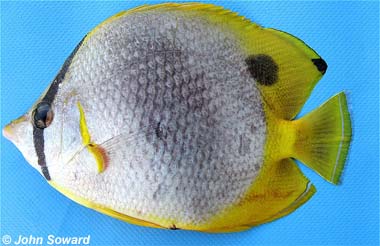
Chaetodon ocellatus
This popular aquarium fish normally inhabits sandy bottom shallows in and around reefs in the Western Atlantic. It has an oval white body and yellow fins, with a black bar running down its face and a signature black spot at the base of its dorsal fin. Spotfins pair up for spawning, and are quite territorial, which can cause problems in an aquarium environment.
Order – Perciformes
Family – Chaetodontidae
Genus – Chaetodon
Species – ocellatus
Common Names
English language common names include spotfin butterflyfish, butterbun, common butterflyfish, katy, school mistress, and two-spotted butterflyfish. Other names are borboleta (Portuguese), chamba blancu (Papiamento), dribob (Marshallese), isabelita de lo alto (Spanish), kulibangbang (Ilokano), macamba blancu (Papiamento), mariposa (Spanish), Nördlicher Falterfisch (German), parche ocelado amarillo (Spanish), and tsumaguro-chochouo (Japanese)
Importance to Humans
This species of butterflyfish is very hardy, making it popular in the aquarium trade. It is not harvested for human consumption.
Conservation
> Check the status of the spotfin butterflyfish at the IUCN website.
The IUCN is a global union of states, governmental agencies, and non-governmental organizations in a partnership that assesses the conservation status of species.
Geographical Distribution
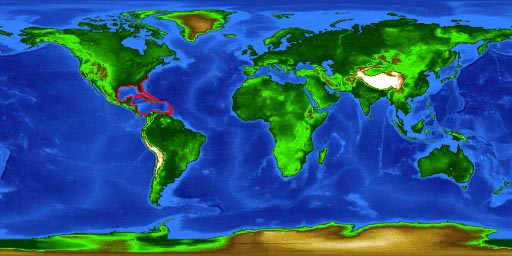
Spotfin butterflyfish occur in the western Atlantic Ocean, most commonly from North Carolina to Brazil. They are found in the Bahamas, Gulf of Mexico and Caribbean. The Gulf Stream current sometimes disperses eggs and larvae northward, resulting in sightings of juveniles as far north as Massachusetts and Canada in the summer months.
Habitat
The spotfin butterflyfish is commonly found on shallow reefs around Florida, with fewer occurrences throughout the Caribbean. Juveniles of this species reside in seagrass beds.
Occurring in pairs or in small groups of 4 or 5, the spotfin butterflyfish swims and feeds over bare, sandy bottoms. This differs from other species of butterflyfish that mainly feed in shallow reef areas.
Biology
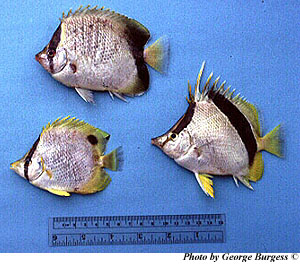
Distinctive Features
The body is thin, deep, and discus-shaped with a small mouth and comb-like teeth.
Coloration
The spotfin butterflyfish has a white body with a black bar that runs vertically through the eye and across the head. There is a second black bar that runs from the base of the dorsal fin to the base of the anal fin in juveniles. A large black spot is located at the base of the soft portion of the dorsal fin and a small black spot on the posterior tip of the fin. A thin yellow bar extends from the gill opening to the base of the pectoral fin. The dorsal, caudal, and anal fins are yellow while the dorsal and anal fins have narrow, submarginal blue bands. This fish undergoes a dramatic change of color at night with dark bands appearing on the body.
Size, Age, and Growth
This butterflyfish grows to a maximum of 8 inches (20 cm) in length, but is more common at lengths of 3-6 inches (7.6-15.2 cm).
Food Habits
During the day it feeds on sea anemones and tube worms. Its small, projectile mouth is adept at crevice feeding, where some of its food likes to hide. The bristle-like teeth, arranged in narrow bands in the jaws, are useful for scraping at the invertebrates, mainly the zoantharians, polychaete worms, gorgonians and tunicates, that make up its diet.
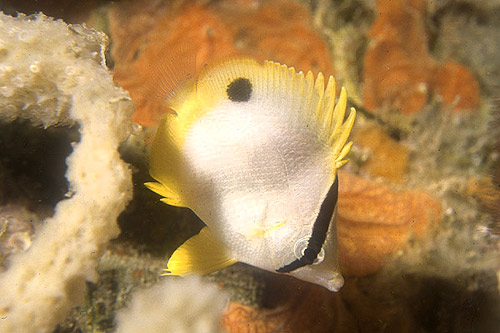
Reproduction
Butterflyfish spawning occurs at dusk and typically involves only pairs. Fish chase each other about the reef during courtship, doing headstands and lateral displays. The pair circle frequently until one fish breaks off and swims away, with the other close behind. Spawning has not been observed in this species, however it is thought to occur year round, peaking in early summer. Within a day after fertilization, the eggs hatch into minute planktonic larvae. The late-stage larvae, called tholichthys, are laterally compressed with characteristic large bony plates extending from the head. The head is encased within bony armor. After reaching approximately 20mm, the larvae settle out of the plankton, onto a hard bottom substrate at night. By morning each larvae rapidly transforms into a juvenile, identifiable as a miniature butterflyfish. The vast majority of young butterflyfish are eaten by shallow water predators, while the survivors quickly locate crevices where they remain until they become adults. It has been observed that the eggs and larvae of this butterflyfish are sometimes carried by the Gulf Stream Current, north to the coastlines of New England and Canada. The juveniles will grow and survive until they perish from the cooler water temperatures as winter approaches.
Taxonomy
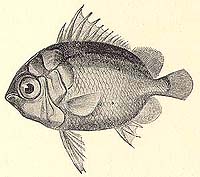
The name “Chaetodontidae” means “bristle-tooth” (“Chaeto” = bristle and “donte” = tooth), describing the teeth found in this family. The spotfin butterflyfish was first described by Bloch in 1781. The species name ocellatus is translated from Latin as “marked with spots”, referring to the spots on this butterflyfish. Synonyms include Chaetodon bimaculatusBloch 1790, Sarothrodus maculo-cinctus Gill 1861, Sarothrodus ataeniatus Poey 1868, Sarothrodus bimaculatus Cope 1870, Sarothrodus amplexicollis Poey 1875, Chaetodon maculocinctus Jordan & Gilbert 1883, and Chaetodon ataeniatus Jordan & Evermann 1898.Prepared by: Casey Patton and Cathy Bester